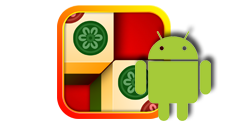Mahjong [solitaire] Guide
How to play:
The goal is to clear the board by removing all the tiles from the layout. Layouts can differ in pattern, size and height. There exist hundreds of different layouts. You must remove the tiles in pairs. A pair consists of two tiles which both are a) “free” and b) identical (or of the same type).
A tile is “free” when:
- no other tile is lying above or is partially covering it
- and no other tile is lying to the left or to the right of it (it can “slide” in one or both these directions..)
Two tiles are identical if they look exactly the same (of course…). An exception to this are the Flowers and Seasons tiles. They are non-identical matching tiles and belong to the same type. All the Flowers tiles match one another and all the Season tiles match one another. You should study them before starting a game.
Each tile appears four times in a standard solitaire mahjongg game. Again an exception for the Flowers and Seasons tiles who appear only once each during a game.
It’s not as easy as it sounds; you can end up with having matched the “wrong” pairs and you may find yourself stuck, with unmatchable tiles blocking other key tiles so you can’t clear the layout. You must be careful before removing a pair, you should look for where the remaining pair is in the layout and plan ahead. If all four of an identical tile are free, remove them to ‘unclutter’ the field. It’s not only a game of pure luck, you have to play strategic.
The tiles:
A Mah-Jongg set consists of 144 tiles. These are split in seven groups, called sets. The three first sets are numeric and they are called suits. The winds and the dragons tiles are called honor tiles. Remember: In the same way as playing cards can have different images for kings and queens, the look of the Mah Jongg tiles differs from game to game. This is specially true for flowers and seasons tiles. And in addition you can often make your own tile sets with pictures of your own choice. The images below are taken from the freeware game ‘Dragonboard’.
The top row of each tile set contains the 9 ball tiles (also known as ‘circle’, ‘badges’ or the ‘dots’ tiles). Their numerical value (1 to 9) are represented by the number of balls shown on the tiles. There are four tiles of every Ball (36 tiles total).
The second row from the top contains the 9 bamboo tiles (also known as ‘sticks’ or ‘bams’). Their numerical value (1 to 9) are represented by the number of sticks shown on the tiles. There are four tiles of every Bamboo (36 tiles total). A peacock, a rice bird or a real Mah Jongg bird [4] (a Sparrow) or occasionally a bamboo shoot which resembles a pineapple is shown on tile number one.
The third row contains the 9 characters tiles (also called the ‘number’, ‘Wan’, ‘Ten Thousand’ or the ‘craks’ tiles). The red symbol is the Chinese sign for 10.000 (and the sign for prosperity). The black symbol above are the sign for the numbers from 1 to 9. That would make them numbers from 10.000 to 90.000. Many games have put Arabic numbers on the corresponding tiles to help people from the western world. There are four tiles of every Character (36 tiles total).
The fourth row starts with the four seasons tiles. Contrary to the above mentioned suits the seasons tiles only appear once each in a game (4 tiles total). From left to right: Spring, Summer, Autumn and Winter. Printed above is the the corresponding abbreviations for the seasons. These tiles can either have an image or a Chinese symbol. When you play solitaire mahjongg games any season will match another season.
The fourth row end with the four wind tiles. From left to right: East, South, West and North. Shown on every tile is the Chinese symbol for the according wind. Again, in computer games, we cheat: The first letter of the wind is printed using Latin characters. There are four tiles of every wind (16 tiles total).
The fifth row starts with four flowers tiles. Just as the seasons tiles, the flowers tiles only appear once each in a game (4 tiles total). From left to right: The Orchid, The Plum Blossom, the Bamboo and the Chrysanthemum. Printed above is the the corresponding abbreviations for the flowers. When you play solitaire mahjongg games any flower will match another flower).
The fifth row ends with the dragons tiles. From left to right: Green Dragon, White Dragon and Red dragon. The white dragon can be a blank tile tile, or it can have an image of an rectangle (outlined in red or blue). There are four tiles of every dragon (12 tiles total).
The Winds and Dragons tiles are important in true mahjongg games, but plays no special role in solitaire mahjongg games where they are treated just like the suites. It’s the other way around with the Flowers and Seasons tiles. In true mahjongg they have no part in the actual play; they are only valuable as bonus points and represents the element of chance in the game. In solitaire mahjongg they are important because they are the only non-identical matching tiles and occur only one time each (as to four times each for the other tiles).
The Strategy:
(Taken from ‘Shanghai Second Dynasty’ Help):
- Remember that there are four of each tile. When removing a pair, remember that an identical pair exists in the layout. Is it trapped by your removal of the first pair? Choose wisely.
- Concentrate your efforts on long rows and tall stacks.
- Plan ahead as many moves as you can.
- If all four of a tile are available, remove them all to unclutter the field.
- Don’t count on the computer to show you the best possible move; the computer only shows the first move it finds [assuming your computer game has a hint function].
- Identify as many matching pairs as possible. Check for tiles that need to be unblocked.
- Beware of triples (three matching free tiles); choose carefully which pair you remove. Leave the one that’s blocking the least important tiles.
- Concentrate on removing pairs that will unblock the most tiles.
TWO-PLAYER
Although this game is often referred to as “solitaire,” you can easily play it with 2 or more people. There are several ways you can do this:
A. Cooperative. No special rules — just work the puzzle together.
B. Competitive. Several ways to go here:
- Speed free-for-all. The two of you attack the layout together, removing pairs. When you remove a pair, put it on your side of the table. At the end (when the layout is clear or unwinnable) the player with the biggest pile of tiles wins.
- Taking turns. Each player gets a turn at removing a pair. A player’s turn ends when the player removes a pair or the player concedes (cannot see a pair to remove). Game ends when the layout is cleared or unwinnable by mutual agreement. Player with biggest tile pile wins.
- Time-limited turns. Get a one-minute timer. Start it at the beginning of each player’s turn. Inevitably, some turns will result in a match being removed and some won’t. At the end (when the layout is clear or unwinnable) the player with the biggest pile of tiles wins.
Source: Tom Sloper


